

Controlled burn. "Back-burn" redirects here.
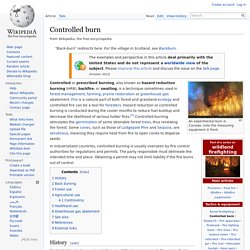
For the village in Scotland, see Backburn. An experimental burn in Canada; note the measuring equipment in front. Firing the woods in a South Carolina forest with a custom made driptorch mounted on an ATV. The device spits flaming fuel oil from the side, instantly igniting the leaf litter. A prescribed burn in a Pinus nigra stand in Portugal Controlled burning of a field outside of Statesboro, Georgia, United States in preparation for spring planting Controlled or prescribed burning, also known as hazard reduction burning (HRB), backfire, or swailing, is a technique sometimes used in forest management, farming, prairie restoration or greenhouse gas abatement.
In industrialized countries, controlled burning is usually overseen by fire control authorities for regulations and permits. History[edit] Savanna Explorer - Northern Australia - North East Queensland - Fire - Trafalgar Station. Vertical farming. Vertical farming is cultivating plant or animal life within a skyscraper greenhouse or on vertically inclined surfaces.
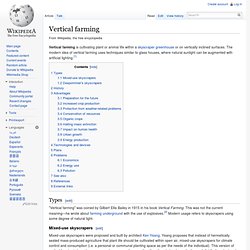
The modern idea of vertical farming uses techniques similar to glass houses, where natural sunlight can be augmented with artificial lighting.[1] Types[edit] The Vertical Farm Project - Agriculture for the 21st Century and Beyond. Food security. 'Extreme' food insecurity (2010)[1] Humans are using an increasing amount of Earth’s annual production of plants Food security is a condition related to the ongoing availability of food.
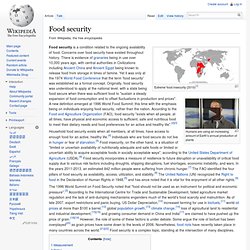
Concerns over food security have existed throughout history. Towards global phosphorus security: A systems fram... [Chemosphere. 2011] - PubMed result. Sustainable agriculture. Australia must lead global move towards soil security - News and Events - University of Sydney. 11 February 2011 Top international soil scientists have called on Australian governments and industry to lead the world in collaborating with farmers to increase soil carbon for improved soil security.
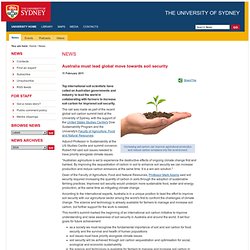
The call was made as part of the recent global soil carbon summit held at the University of Sydney, with the support of the United States Studies Centre's Dow Sustainability Program and the University's Faculty of Agriculture, Food and Natural Resources. Adjunct Professor in Sustainability at the US Studies Centre and summit convenor, Robert Hill said soil issues needed to have priority alongside climate issues. "Australian agriculture is set to experience the destructive effects of ongoing climate change first and hardest.
By improving the sequestration of carbon in soil to enhance soil security we can increase production and reduce carbon emissions at the same time. Land Manager. You can use this site to search for information about a specific area or topic by selecting your 1: Region, 2: Topic, 3: Item Type and/or 4: enter a Keyword. Clicking on further topics or regions will produce new lists of information. Information produced from your search is shown both on the map and in the results list next to the map. This website was created by the NT InfoAccess program supported by Territory NRM, Charles Darwin University and the Northern Territory Government. It aims to meet the information needs of north Australian land managers including pastoralists, Landcare groups Indigenous groups and government agencies.
It enables people to make better land management decisions by providing information on the soils, pasture and plants and animals that need to be looked after, and on the problems land managers face, such as wildfire, weeds and pest animals. The Future of Food - Landline - ABC. ANNE KRUGER, PRESENTER: After promising a national food plan during last year's election, this week the Federal Government gave a glimpse of what might be in it with the release of an issues paper.
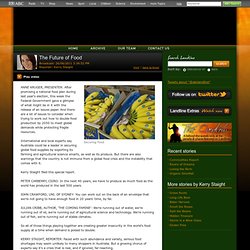
And there are a lot of issues to consider when trying to work out how to double food production by 2050 to meet global demands while protecting fragile resources. International and local experts say Australia could be a leader in securing global food supplies by exporting its farming and agricultural science smarts, as well as its produce. International Fund for Agricultural Development. IFAD logo The International Fund for Agricultural Development (IFAD) (French: Fonds international de développement agricole; FIDA) (Italian: Fondo Internazionale per lo Sviluppo Agricola) is a specialized agency of the United Nations dedicated to eradicating rural poverty in developing countries.

It was established as an international financial institution in 1977 as one of the major outcomes of the 1974 World Food Conference. Seventy-five per cent of the world's poor live in rural areas in developing countries, yet only 4% of official development assistance goes to agriculture. The coming famine: risks and solutions for global food security. Growing scarcities of water, land, oil and nutrients will combine with climate change to create a serious threat to global food security in coming decades.

These could result in major regional famines, wares and refugee crises, Julian Cribb warns. Image: richardmasoner, Flickr CC-licensed. Please click on the images to enlarge. Most of us have by now heard the forecast there will be 9.2 billion people in the world of 2050. But current projections suggest human numbers will not stop there – but will keep on climbing, to at least 11.4 billion, by the mid 2060s.
Equally, the world economy will continue to grow – and China, India and other advancing economies will require more protein food. Thus, global demand for food will more than double over the coming half-century, as we add another 4.7 billion people.